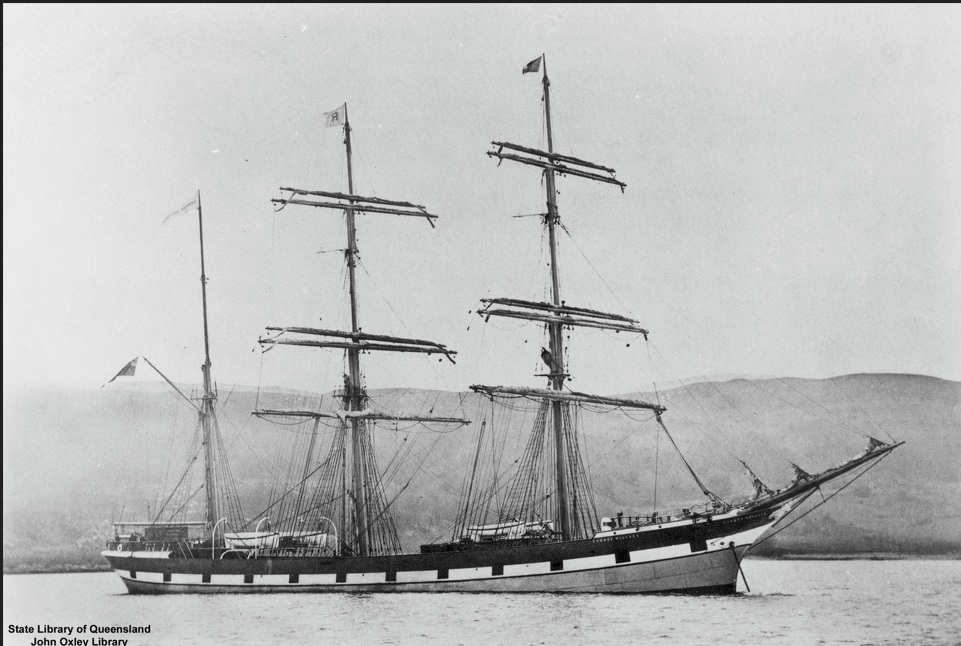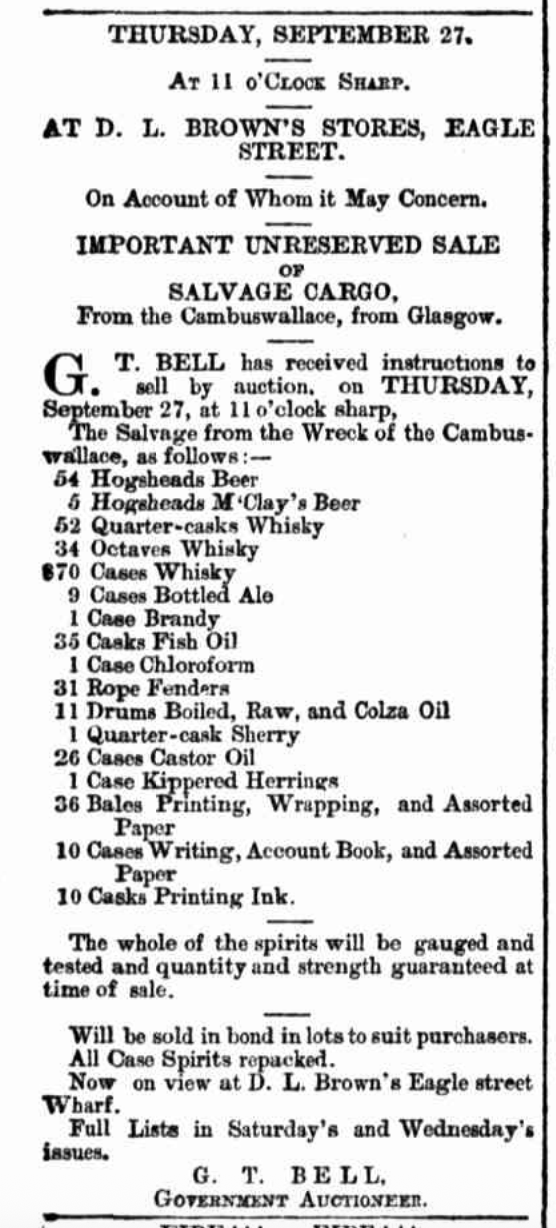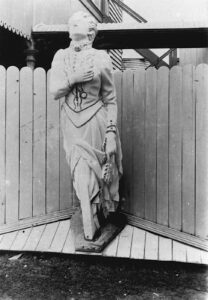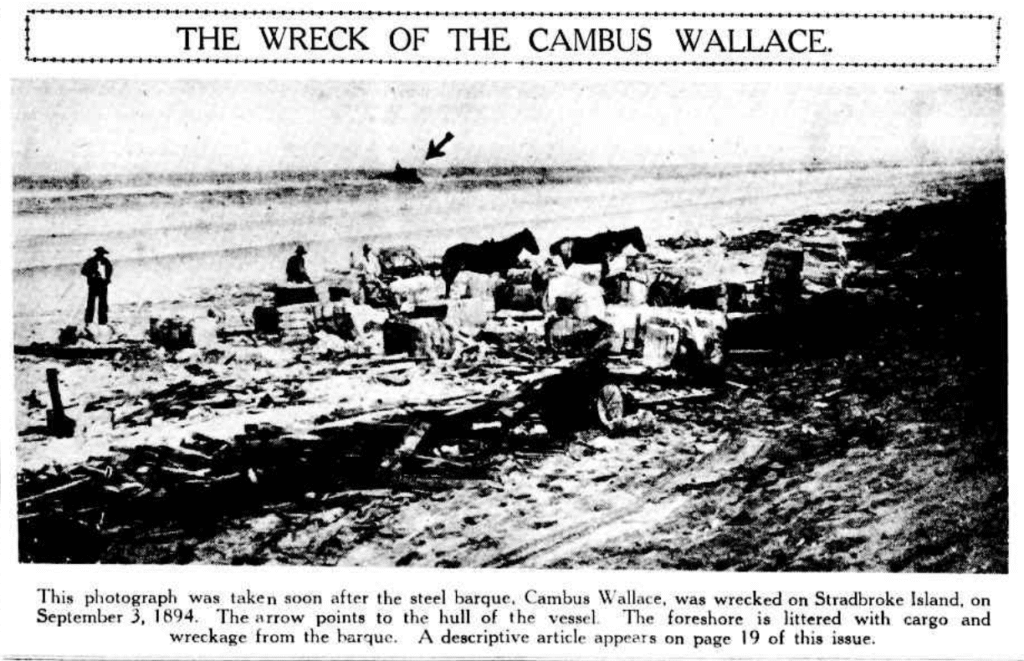The Cambus Wallace: tragedy and souvenirs from the sea.

Cambus Wallace: new, pristine, and elegant.
On 3 September 1894 the ship Cambus Wallace, buffeted by strong winds, was wrecked at Jumpin Pin on the ocean side of an isthmus connecting North and South Stradbroke Island, about 24 kilometres north of Southport. Thomas Welsby, who arrived on the scene soon after, described the result, ‘In less than twenty-four hours the Cambus Wallace had become broken, torn, and smashed beyond all recovery, nought remaining to be seen but heavy breakers spuming over a sand embedded vessel beneath the ocean’s waters, and above those waters a deck broken mizzen mast.’ Telegraph 9 February, 1929 p12.

Grave of Cambus Wallace victims now destroyed by wind and waves.
It was a merchant ship, without passengers, on its maiden voyage, so the victims of the ferocious seas were 6 crew who were buried on Stradbroke Island. The rest, in a terrible state, were brought to Brisbane on the government vessel, Miner. Great sympathy was extended to the twenty-one survivors and money was raised to assist them. In the Brisbane Courier 5 September 1894 p5 the dead and the living seamen were named. The photographs of the survivors featured in the Queenslander 15 September 1894 p505.
The cargo
Attention soon focused on the goods the Scottish vessel brought to Queensland. At a time when food processing and manufactured materials were desirable but not made here the treasure could have been a rich booty for the unscrupulous. Several insurance companies were interested and Customs soon put a guard on the cargo liberally littered along the Stradbroke Island beach.
Dynamite
Goods, except for the dynamite, were brought to Brisbane for auction. It was decided to blow up all the explosives in the sand. It is considered likely that the dynamite explosion, undermining rock beneath the sand, combined with ferocious waves to break through the isthmus which joined them. Today North and South Stradbroke are separated by a body of water as a result.
The auction of salvage
As far as many were concerned, the Scotch whisky, bottled and in casks, was a desirable acquisition. It was said that sales of spirits declined as customers waited for the salvage auction. The quantity of paper and printing ink, listed below, is one of the reminders of how much Queensland relied on overseas supplies for what in those days were essentials.

Telegraph 21 September 1894 p8.
Relic and reminder of the tragedy
The wreck was also salvaged but one item which survived for many as a reminder in Southport of the tragedy was the ship’s figurehead which graced the front of the Railway Hotel. Mr. Downes, the hotel proprietor, and a friend towed it to Southport. In the Telegraph 31 October 1929 p20 the significance of its final removal was brought to public attention.
Mementoes of the Cambus Wallace down the years

Figurehead of the Cambus Wallace.
Enthusiasts sifted sand and coastal areas for the prize whisky and other goods which were frequently sought and occasionally reported. One such find, several bottles, were retrieved by divers from the ocean. It was a reminder of the days when aerated water manufacturers abounded in the cities and towns. Ginger beer bottles with their essence were imported from Scotland, another example of everyday items coming from outside the country. James Ryan had purchased Artesian Aerated Waters in 1890 and moved the business eventually to Prospect Terrace, Highgate Hill. By the time the bottle from the Cambus Wallace was presented to his widow and son he had been dead for over 30 years, and there were many fewer aerated water cordial businesses.
The legacy of the Cambus Wallace
There were many newspaper articles over the years about the wreck of this ship on its maiden voyage. They were often part of items about a number of wrecks around Southport, noted for the terrible damage done to human lives and prized cargo. Their legacy lives on in the stories of the seas and the mementoes which surface from time to time, echoes of the daunting nature of the Queensland coast and a different way of living. The objects we keep and treasure such as a ship’s masthead or historic bottles link us to this wild Queensland history.


This is a nice little story that I have a personal connection with. My gg grandfather, John Coote Snow, was employed by Brabant & Co, sole agents for Nobel’s Explosives Manufacturing Company. John Snow was charged with the duty of superintending the delivery and storage of explosives. Although I haven’t yet found any newspaper articles naming him personally as being connected to the wreck of the Cambus Wallace, his son confirmed in his eulogy that he was in charge of destroying the damaged exlosives left on the beach when the CW was wrecked. I’d appreciate hearing if anything is ever found that provides documented evidence of JC Snow’s connection to the disposing of the dynamite. Thank you.
A fascinating extension of the story Georgina!
Stephanie Ryan